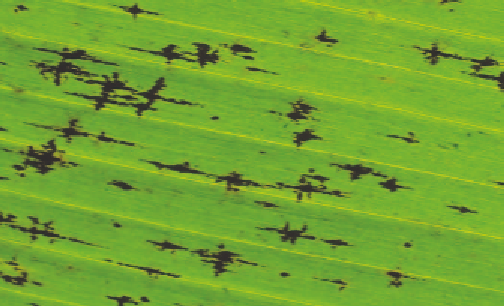Agriculture Reference
In-Depth Information
Importance
The disease is serious only on cooking bananas growing on
Murray Island in the Torres Strait. It also attacks Lady finger
(pome-type) but Cavendish varieties are resistant.
Management
Management is not warranted.
BLACK PIT
■
Cause
The fungus
Pyricularia grisea
.
Fig 5.14 Close up of black-cross symptoms.
Symptoms
On fruit, small red spots develop, enlarging to shallow
black pits 3-6 mm wide. Pitting is most abundant on the
upper hands of a bunch and on fingers on the exposed side
of a bunch. The centres of mature pits may split. The
Source of infection and spread
Spores of the fungus (ascospores) are produced in small
fruiting bodies (perithecia) embedded in black fungal
tissue visible on the leaf surface. The spores spread the
disease to new leaves and plants.
BLACK SIGATOKA - BIOSECURITY THREAT
Cause
The fungus
Mycosphaerella fijiensis
.
Symptoms
Both black Sigatoka and yellow Sigatoka (caused by
Mycosphaerella musicola
) cause narrow streaks parallel
to the leaf veins. Early lesions of black Sigatoka are
reddish-brown and found on the underside of leaves;
yellow Sigatoka lesions are yellowish-green and more
evident on the upper side of leaves. Lesions of both
fungi develop into dark brown to black lesions with
water-soaked borders surrounded by a narrow yellow
halo. The centres dry out and become depressed, and
turn light grey, buff or beige. Many spots will cause
large dead areas or leaf collapse.
Source of infection and spread
The black Sigatoka fungus is more virulent, has a shorter
life cycle and is harder to control than the yellow Sigatoka
fungus. Spread and infection are favoured by wet, windy
weather. Transporting leaves and sword suckers spreads
the fungus to new areas.
Fig 5.15 Black Sigatoka symptoms on banana.
Importance
This disease does not occur in commercial growing
areas. It is present in the Torres Strait region and poses a
threat to banana production in Australia.













